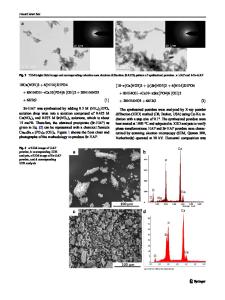Synthesis, Sintering and Microstructural Characterization of Nanocrystalline Hydroxyapatite Composites
- PDF / 4,309,702 Bytes
- 6 Pages / 612 x 792 pts (letter) Page_size
- 76 Downloads / 583 Views
AA5.31.1
Synthesis, Sintering and Microstructural Characterization of Nanocrystalline Hydroxyapatite Composites B. Viswanath 1, N. Ravishankar 1 , Suprabha Nayar 2 and Arvind Sinha 2 1 Materials Research Centre, Indian Institute of Science, Bangalore, India. 2 National Metallurgical Laboratory, Jamshedpur, India. ABSTRACT Nanocrystalline hydroxyapatite (HAp) exhibits better bioactivity and biocompatibility with enhanced mechanical properties compared to the microcrystalline counterpart. In the present work, nanocrystalline hydroxyapatite was synthesized by wet chemical method. Sintering was carried out with nanocrystalline alumina as additive, the content of alumina being varied from 10 to 30 wt% in the composite. For 20 and 30 wt % Al2O3, hydroxyapatite decomposed into tricalcium phosphate (TCP) above the sintering temperature of 1100oC. The fracture toughness of nano HAp-nano Al2O3 composite is anisotropic in nature and reached a maximum value of 6.9 MPa m1/2. INTRODUCTION Nanocrystalline hydroxyapatite Ca10(PO4)6(OH)2 is known to possess unique biological and physical properties that makes it an ideal substitute for human bone. Its chemical similarity with the bone makes it a biocompatible ceramic [1]. Nano HAp provides excellent bioactivity arising from the very high surface area for integration into bone[2] but cannot be used as a implant for load bearing applications due to its poor mechanical properties such as toughness and bending strength. Recently, nanocomposites have received much attention due to the advantage of simultaneous increase in toughness and strength. It is reported that nanosize alumina provides bioactivity where as alumina is bioinert in conventional polycrystalline form [3]. Various reinforcing agents have been employed in the earlier studies to improve the mechanical properties of the HAp composites. Among those, alumina is one of the most widely investigated reinforcement material for HAp composites. However, very few reports are available in the literature on hydroxyapatite based nanocomposites[4-6]. Many questions such as the effect of particle size on the phase stability of HAp in composites and change in mechanical properties such as toughness remain unanswered. The synthesis, sintering and characterization of HApAl2O3 composites, prepared from nanoparticles of both alumina and HAp, has been carried out in the current investigation. EXPERIMENTAL PROCEDURE Hydroxyapatite nano powder was prepared by drop wise addition of diammonium hydrogen phosphate into a calcium nitrate solution and the pH of the mixture was adjusted to 11 with the addition of ammonium hydroxide solution. After the completion of the precipitation reaction, the precipitate was kept at room temperature for 48 hours. Then, the precipitate was washed, filtered and dried at 100oC for 12 hours. Similarly, alumina nanoparticles were also prepared by the wet chemical method. An aqueous solution of ammonium nitrate was added into the aqueous solution of aluminium nitrate. 30 ml of ammonium hydroxide solution was added to
A
Data Loading...










